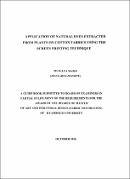| dc.description.abstract | In this study experimented with the usage of natural dyes extracted from plants to
decorate sample fabrics using Screen printing technique. This research were guided by
the following objectives:
I . To analyze various plants in Uganda for extraction of dyes to decorate fabrics using
screen printing technique.
2. To extract natural dyes that can be applied on to cotton fabric using screen printing
technique
3. To experiment with natural dyes to decorate fabrics using screen printing technique.
4. To produce screen printed sample fabrics using natural dyes.
The study focused on seven plants namely, sweet potatoes, yam (balugu), turmeric
(ldnzali), Momordica foetida (boobo), bidens pilosa (ssele), Madder (Manjistha) and
vernoma amygdalina (mululuza). The researcher extracted colorants using the local
methods of extraction. In chapter two of the study showed that they were many methods of
extraction. The different methods for extraction of coloring materials were Aqueous
extraction, Alkali or acid extraction, Microwave and ultrasonic assisted extraction,
Fermentation, Enzymatic extraction, Solvent extraction, Super critical fluid extraction
however, the researcher used local ways of extracting dyes from plants like pounding,
squeezing, soaking and boiling the different parts of the plant because it had an advantage
over the acid extraction which is harmful to the human health.
The study experimented with different three recipes as shown in table one and also used
four thickening agents which were sodium alginate, gum Arabic, textile thickener and book
binding gum. All the three yielded the same results on the Colour fastness to washing.
However, book binding glue was not good on the print sharpness when using vernonia
amygdalina.
The study used the recipes in table one the researcher formed printing paste which was used
to print sample fabrics. The study also used a direct photographic method of screen | en_US |

